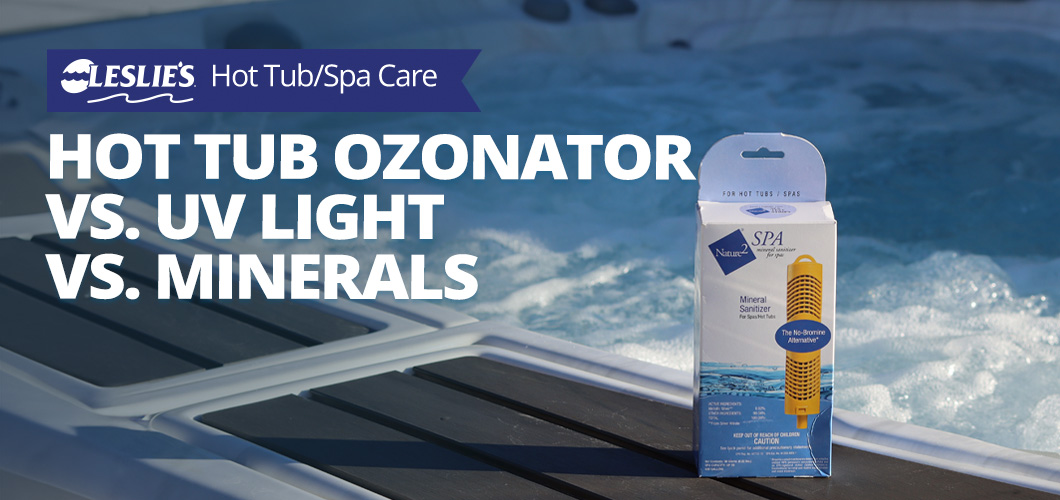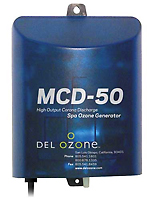
Hot Tub Ozonator VS. UV Light VS. Minerals
When it comes to sanitizing your spa or hot tub, you have a lot of choices. Chlorine and bromine are an easy way to keep the water consistently sanitized, but they have a few disadvantages. The two chemicals can smell bad, bleach suits, dry out skin and hair, and can be unsafe to store and use. So if you're looking for some alternate hot tub sanitizers, you're in luck! There are three popular alternatives that help keep your hot tub clean and safe: ozonators, ultra violet light, and mineral purifiers.
Alternate Hot Tub Sanitizer #1: Ozone

How it works:
Ozone is called the 'World's Most Powerful Sanitizer' and indeed packs quite a punch. An ozonator or ozone generator shoots a small electric charge across an air filled gap to separate oxygen O² into O¹. The singular oxygen atom quickly bonds to a nearby O² molecule, to become O³, or Ozone. The additional oxygen atom makes O³ very unstable, destroying any unfortunate particle that gets in the way.
Down side:
Ozone is cheap to produce, however the circulation pump must be running, to draw the gas into the line. When the pump is off, ozone is not being produced. Ozone also has a very short life, and due to the gaseous state, it will rise to the surface and gas-off quickly.
Maintenance:
Spa ozonators require replacement of the ozone tubing and check valve every 1-2 years. CD (Corona Discharge) models require CD Chip replacement every 1-2 years, while AGP (Advanced Plasma Gap) units can last up to 5 years.
Effectiveness:
Using a spa ozonator can allow you to reduce reliance on high levels of chlorine and bromine, by as much as 50%, according to manufacturers. Ozone destroys Giardia, Pseudomonas and Crypto and is a powerful oxidizer.
Alternate Hot Tub Sanitizer #2: UV Light
How it works:

UV light purifiers work by irradiating the water, as it rushes by a UV lamp that is producing a specific wavelength 254 nm within the UV-C spectrum. When exposed to UV light of this specific wavelength, living particles actually have their DNA rearranged and become unable to reproduce. This renders the particles as inert, and only from a millisecond of exposure to the UV-C light.
Down side:
Like Ozone, UV light is cheap to produce, but is only being produced while the pump is running, pushing water over the UV-C light bulb or lamp. UV system strength can be reduced by high water flow rates, cloudy water and water temperature. And it has no 'shelf life', sanitation only takes place for an instant, while the water is passing under the eerie blue light.
Maintenance:
Spa UV light systems use a special bulb to create the UV-C light. In most cases, these bulbs will need to be replaced every 1-2 years, as they begin to lose effectiveness over time. Cleaning the quartz lens regularly is also recommended, to remove dust or grime deposits.
Effectiveness:
Like Ozone, UV purification is a tried and true secondary sanitizer, and can reduce your reliance on chlorine or bromine. It also inactivates (renders inert) parasites and pathogens like Ozone, when sized and used properly.
Alternate Hot Tub Sanitizer #3: Mineral Purifiers
How they work:
Mineral purifiers for hot tubs and spas are slim cartridges that you drop into the hole in the center of your cartridge filter. They're filled with silver and copper pellets, which slowly dissolve at a controlled rate. The silver and copper act together as a biocide, with silver oxide as the sanitizer and copper working as an algaecide. Using a mineral stick, like the others, can allow you to reduce chlorine or bromine usage by up to 50%.
Down side:
Mineral sticks for spas are also not as powerful as ozone, and cannot kill the strongest of pathogens that may come into the water, although they come close.
Maintenance:
Most mineral sticks are replaced every 4 months, when the silver and copper depletes. No other equipment involved, so no other maintenance is needed.
Effectiveness:
Unlike ozone and UV, mineral sticks create lasting protection by maintaining a residual of silver in the water. You will notice an immediate improvement in water quality and can appreciate using less sanitizer or filter aids to keep the water clear.
Your mileage may vary, but having a secondary sanitizer makes sense and is recommended by the MAHC (Model Aquatic Health Code). It can help reduce reliance on harsh chlorine or bromine, and also acts as a nice back-up for those occasional gaps in coverage, if you know what I mean.
In most cases, all of these systems tend to cost the spa owner about $100 per year, but you can realize some savings in other chemical costs, and will enjoy the peace of mind knowing that your spa water is extra-clean, I know I do! I use Nature2 and Del Ozone on my own spa.